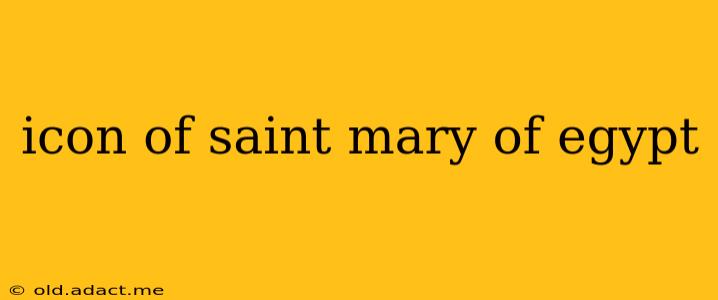Saint Mary of Egypt, a figure of profound transformation and unwavering faith, holds a unique place in the hearts of Orthodox Christians and others drawn to stories of radical repentance and divine grace. While there isn't one single, universally recognized "icon" of Saint Mary of Egypt, numerous artistic representations depict her life's journey, emphasizing key moments of her conversion and subsequent ascetic life in the desert. These images offer a powerful visual narrative of her spiritual struggle and ultimate triumph. This exploration delves into the common iconographic elements and the symbolism behind them, addressing common questions surrounding this compelling saint.
What are the common features of Saint Mary of Egypt icons?
Icons of Saint Mary of Egypt typically portray her in various stages of her life. Early depictions might show her youthful, alluring beauty, contrasting sharply with later images reflecting her years of penance in the desert. Common features include:
- Her Hair: Often depicted as long and flowing, sometimes covering her shoulders or partially concealing her face, symbolizing her former life of worldly allure. Later depictions might show it more neatly arranged, reflecting her changed lifestyle.
- Her Clothing: Initially, she's often shown in richly colored clothing, suggestive of her past life. As the icon progresses through her life, her clothing becomes increasingly simple, often reduced to roughspun robes or even nudity, representing her renunciation of worldly possessions.
- Her Posture and Expression: Her facial expression can vary greatly depending on the specific moment in her life being depicted. Early images might convey a sense of worldly vanity, while later ones often show humility, serenity, and a profound inner peace. Her posture may reflect prayer, penitence, or contemplation.
- Desert Setting: Many icons show her in a desert landscape, highlighting her ascetic life and solitude, often with symbolic elements like a palm tree, symbolizing life in harsh conditions sustained by divine grace, or a cross, underscoring her faith.
- Zosimos the Monk: Frequently, Zosimos, the monk who encounters her in the desert, is depicted alongside her, often smaller in scale to emphasize Mary's central role in the narrative. This juxtaposition highlights the transformative power of God's grace, revealed through her extraordinary life.
What does the iconography of Saint Mary of Egypt symbolize?
The iconography of Saint Mary of Egypt is rich in symbolism, going beyond a simple visual representation. The artist uses imagery to convey the spiritual journey she undertook:
- The Transformation from Sin to Holiness: The visual contrast between her early and later depictions powerfully illustrates the transformative power of repentance and God's unwavering mercy.
- The Power of Repentance: Her story is a testament to the possibility of radical transformation, regardless of past sins. The icon serves as a visual reminder of God's forgiveness and the transformative potential of genuine repentance.
- The Importance of Asceticism: Her life in the desert, often depicted in the icon, emphasizes the importance of spiritual discipline and detachment from worldly pursuits in the pursuit of holiness.
- Divine Mercy: The overall message of the icon points towards the boundless mercy of God, capable of redeeming even the most seemingly irredeemable soul.
How are Saint Mary of Egypt icons used in worship?
Icons of Saint Mary of Egypt, like other holy images, are venerated in Orthodox Christian churches. They are not worshipped as idols but serve as a focal point for prayer and contemplation. Devotees pray before the icon, seeking her intercession and drawing inspiration from her life of repentance and unwavering faith.
Where can I find examples of Saint Mary of Egypt icons?
While a definitive list is impractical (as countless variations exist across various artistic traditions and time periods), searching online image databases using keywords like "Saint Mary of Egypt icon," "Icon of Saint Mary of Egypt," or "Mary of Egypt iconography" will yield a wide variety of examples. Many Orthodox Christian websites and blogs feature such images, providing varied representations of this compelling saint. Additionally, many museums and art collections possessing religious art hold examples of these icons.
What are some key moments in the life of Saint Mary of Egypt depicted in icons?
While not every moment is always depicted, commonly shown scenes in icons include:
- Her youthful life of sin: Showing her surrounded by worldly pleasures.
- Her encounter with Zosimus: Their first meeting in the desert.
- Her death and burial: Often portraying her peaceful passing and the miraculous appearance of the inscription after her death.
- Her life in the desert: Usually showing her in simple attire, possibly with few possessions, symbolizing her austere life of repentance.
The icon of Saint Mary of Egypt serves as a powerful visual testament to the transformative power of faith, repentance, and God's boundless mercy. Its symbolism continues to resonate with believers and art enthusiasts alike, offering inspiration and hope to those seeking spiritual guidance and transformation.
